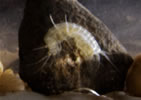Aerobic (bacteria) - requires the presence of oxygen
Allogenic drainage – underground drainage that is derived entirely from surface run-off on adjacent non-karstic rocks e.g. gritstone, sandstone. These streams will bring surface dwellers in to the cave along with organic debris, especially in flood.
Anaerobic (bacteria) - can live in the absence of, and does not require, oxygen
Amphipod - a type of crustacean with the body flattened laterally e.g. freshwater shrimp.
Successive pairs of limbs tend to be modified differently.
Arthropod - invertebrate in the phylum Arthropoda having jointed limbs, segmented body and exoskeleton made of chitin e.g. crustaceans, insects, spiders, mites, ticks, millipedes.
Autogenic drainage – underground drainage derived entirely from water that has originated on the karst surface.
Base rich - rocks/soils with relatively little silica (as opposed to acidic that have relatively high levels).
Biomicrite - fine grained mud containing significant amounts of fossils. The finer the grain the lighter the colour of the limestone.
B.P. - years before present; as a convention, 1950 is the year from which B.P. dates are calculated. It is commonly used when radio carbon dating.
Freeeliving - animals and plants that live independently i.e. not parasitic.
Cavernicole - a more general term for a creature that lives in a caves and can complete its life cycle there, but may also live in other dark habitats e.g. soil, under stones, bark. It includes troglophiles and troglobites, not visitors.
Chemotroph - Chemotrophs are organisms that obtain energy by the oxidation of electron donating molecules in their environments. The chemotroph designation is in contrast to phototrophs which utilize solar energy. Chemotrophs can be either autotrophic (utilise simple inorganic sources such as carbon dioxide, water, nitrates), or heterotrophic (energy obtained from oxidation of organic compounds).
Endogean – living in the zone immediately beneath the earth’s surface
Epigean – living on the surface of the earth
Guano – accumulated deposit of animal droppings. It is an important food source for some troglobites.
Hypogean – living in regions deeper than the epigean
Isopod - a type of Crustacean with flattened bodies (as if they have been stood on like a woodlouse). The seven pairs of visible legs are essentially similar.
Karst – landscape in soluble rock with efficient underground drainage, usually limestone.
Limestone – sedimentary rock containing over 50% calcium carbonate by weight.
Lux - the SI (International) unit of illuminance, frequently defined as one lumen per square meter (lm/m2). (One lux equals 0.0929 footcandles).
Micrite - a fine smooth limestone due to microscopically sized grains, the word is derived from MICRocrystalline calcITE. It forms in quiet water and the fossils are well preserved.
Moonmilk – white fine grained mineral deposit consisting of mixture of calcite, aragonite, complex carbonates. Its origin is unclear but may involve bacteria.
Niche (ecological) – ecological lifestyle of an organism, usually unique to that particular species.
Pleistocene epoch 2.588 million years -12,000 years BP, it includes all eleven recent major ice ages and many smaller ones. It is the first epoch of the Quaternary period.
Protozoa- minute, mostly microscopic, aquatic or parasitic single-celled animals, whose single cell performs all their life functions.
Silicified – process during fossil formation in which organic matter is replaced by silica.
Sparite - a rough limestone due to the grains being the size of sand or larger
Stygobite - aquatic troglobite
Troglobite - cannot complete life cycle outside of the cave environment. These have morphological adaptations to the cave environment e.g. blind, longer legs, lower metabolic rate.
Troglodyte – person who lives underground
Troglophile - can successfully complete its life cycle both in and out of the cave environment.
Trogloxene – species making use of a cave for shelter.
.jpg)
Shuttleworth Pot, Leck Fell |
|
|

